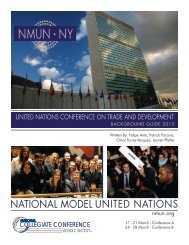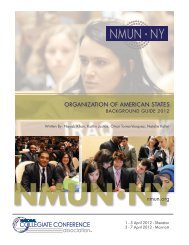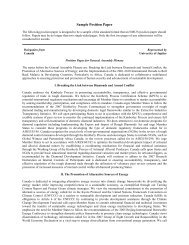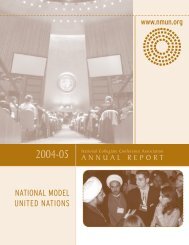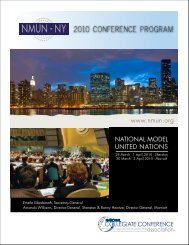UNFPA Background Guide - National Model United Nations
UNFPA Background Guide - National Model United Nations
UNFPA Background Guide - National Model United Nations
Create successful ePaper yourself
Turn your PDF publications into a flip-book with our unique Google optimized e-Paper software.
I. Health Priorities Post-2015: Opportunities and Challenges for Improving Maternal<br />
Health<br />
“As we've seen, the mere fact that women and girls can drive development isn't enough. What is needed is a system<br />
designed to put them in the driver's seat.” 42<br />
Introduction<br />
It is impossible to deny that maternal health – fertility, reproductive rights, family planning, contraceptives,<br />
midwifery, ante- and post-natal care – are inextricably linked to the health of the global future. 43 Mothers are giving<br />
birth to the world’s prospects for a safe, equal, and peaceful planet. While this is a simple concept, it has proven far<br />
too easy for many States to overlook the value of providing child bearers easy access to maternal health care, and<br />
especially good maternal health care. 44<br />
An essential tenet of <strong>UNFPA</strong>’s Mission Statement is: “…to ensure that every pregnancy is wanted, every birth is<br />
safe, every young person is free of HIV/AIDS, and every girl and woman is treated with dignity and respect.” 45 The<br />
international community recognized the importance of maternal health when developing the eight Millennium<br />
Development Goals (MDGs), naming Goal 5 “Improve Maternal Health.” 46 The 2013 evaluation of MDG 5<br />
indicates that maternal mortality has fallen by nearly half (47%) since 1990, which is far short of the goal of a threequarters<br />
reduction. 47 The other pillar of MDG 5, universal access to reproductive health, also falls short of the<br />
ambitious goal of improving maternal health in terms of antenatal care, contraceptive use and access, and family<br />
planning services (though figures vary regionally). 48 From a purely statistical standpoint, there is no doubt that the<br />
spotlight of the MDGs on maternal health care has been a boon to maternal health. With the 2015 MDG deadline<br />
looming, <strong>UNFPA</strong> must ask a tougher question: Will maternal health continue to receive its due attention after the<br />
2015 deadline has passed? To go further: How can maternal health become central to global health and development<br />
policy post-2015?<br />
International and Regional Framework<br />
As the primary body concerned with population activities in the UN system, <strong>UNFPA</strong> provides support for efforts to<br />
improve maternal health around the world in partnership with other UN agencies, NGOs, local communities,<br />
foundations, and governments. 49 The 1994 International Conference on Population and Development in Cairo,<br />
Egypt, resulted in a Programme of Action (PoA) that guides the work of the <strong>UNFPA</strong> and includes Reproductive<br />
Rights and Reproductive Health as a major tenet. 50 The objectives of this prong of the PoA seek a world with<br />
comprehensive family planning and reproductive health care services, women’s access to information and education<br />
about fertility to aid in their family planning decision making, and meeting reproductive health needs “in ways<br />
sensitive to the diversity of circumstances to local communities.” 51 The PoA is periodically reviewed and informs<br />
the mandate and work of the <strong>UNFPA</strong> and therefore the efforts of the organizations that support the efforts of the<br />
<strong>UNFPA</strong>. 52<br />
The Global Programme to Enhance Reproductive Health Commodity Security (GPRHCS) is a <strong>UNFPA</strong> initiative<br />
launched in 2007 that works with 46 governments to ensure women’s access to all manner of sexual and<br />
reproductive health supplies which in turn positively affects the quality of maternal health. 53 Through the GPRHCS<br />
42<br />
Gates, Bridging the Gender Gap, 2013.<br />
43<br />
World Federation of <strong>United</strong> <strong>Nations</strong> Associations, 2015 and Beyond: Perspectives on Global Development, 2013, p. 22.<br />
44<br />
Ibid., p. 22-23.<br />
45<br />
<strong>UNFPA</strong>, Our Mission [Website].<br />
46<br />
UN Department of Economic and Social Affairs, The Millennium Development Goals Report 2013, 2013.<br />
47<br />
Ibid.<br />
48<br />
Ibid.<br />
49<br />
<strong>UNFPA</strong>, Our Mission [Website].<br />
50<br />
<strong>UNFPA</strong>, The Programme of Action of the International Conference on Population and Development [Report], 1994, p. 45.<br />
51<br />
Ibid., p. 47<br />
52<br />
<strong>UNFPA</strong>, Our Mission [Website].<br />
53<br />
<strong>UNFPA</strong>, Strategic Approaches [Website], 2013.<br />
11



